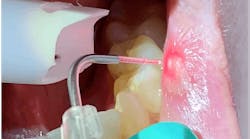EPA issues final rule requiring dentists to install amalgam separators
On December 15, the Environmental Protection Agency (EPA) issued a final rule under the Clean Water Act mandating specific pretreatment standards to control discharges into publicly owned treatment works. The new rule requires dental practices that place or remove dental amalgam to control amalgam waste through the use of ISO 1143-certified amalgam separators.
While the rule will go into effect 30 days after it is published in the Federal Register, the compliance date for most dental practices is not until three years from now, at the end of 2019.
The EPA ruling explained
Each time an amalgam filling is placed or removed, tiny particles of mercury bypass chairside traps and make their way into our wastewaters. In fact, the EPA estimates that 50% of the mercury pollution in our wastewaters is attributed to dental amalgam. While treatment plants capture most of the mercury, about 10% is distributed into the environment as sludge that is either incinerated, applied to the land as fertilizer, or deposited in landfills. From there, bacteria convert it into methylmercury, a neurotoxin that builds up in fish and the mammals that consume them, including humans.
In order to control the discharge of mercury into publicly-owned treatment works, the EPA has issued a final rule requiring all dental practices that place or remove amalgam to install an amalgam separator. The rule states that the amalgam separator must be compliant with either the American National Standards Institute American National Standard/American Dental Association Specification 108 for Amalgam Separators (2009) with Technical Addendum (2011), or the International Organization for Standardization 11143 Standard (2008) or subsequent versions as long as that version requires amalgam separators to achieve at least a 95% removal efficiency.
Dental practices that already have amalgam separators will be required to replace the equipment within 10 years of the rule’s effective date with equipment meeting the new standard.
The rule also states that a dental facility that places or removes amalgam is subjected to two best management practices:
1) Collect and recycle scrap amalgam.
2) Clean the chairside traps with non-bleach or non-chlorine cleanser so as not to release mercury.
The EPA noted these regulations do not apply to mobile units or dental offices that only implement the following specialties:
• Oral pathology
• Oral and maxillofacial radiology
• Oral and maxillofacial surgery
• Orthodontics
• Periodontics
Additionally, there are reporting requirements. All dental facilities must submit to the local authority a compliance report and have maintenance and inspection records available for inspection.
More about amalgam separators
Amalgam separators are essentially glorified “solids collectors” that are installed on the main vacuum line and use gravity to capture any particles that might have bypassed chairside traps before they reach the sewer. The typical plumbing configuration in a dental office involves a chairside trap for each chair and a central vacuum pump with a vacuum pump filter. Chairside traps and vacuum pump filters remove approximately 78% of dental amalgam particles from the waste stream. These chairside traps cannot be cleaned or washed; they must be recycled to ensure that amalgam particles are properly managed.
Depending on the brand, a separator can be purchased from virtually any supply vendor or directly from the manufacturer. Whatever separator is used, it is important that the system is promptly installed in order to comply with the new regulations. Proper documentation management is an integral part of this program to ensure that a certificate of recycling is kept on file, and a replacement canister is purchased once the marked fill line is reached, or 12 months from the date of installation, whichever occurs first.
Next steps for dentists
To eliminate your amalgam liability and ensure compliance with the new EPA final ruling, use this simple three-step action plan to find the best amalgam separator for your practice.
Step 1: Determine your capacity requirements (number of chairs in practice).
Step 2: Check the dimensions to make sure the separator will fit in the space allotted.
Step 3: Purchase and install the amalgam separator by the end of 2019.






